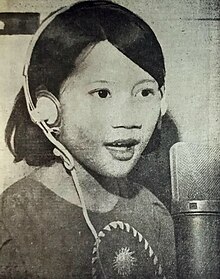Copy Thachin
| Copy Thachin | |
|---|---|
 Popular Burmese Copy Thachin band Iron Cross | |
| Etymology | "Copy Song" |
| Stylistic origins | |
| Cultural origins | 1980s, Burma |
Copy Thachin, or simply "Copy Music" is a genre of music in Myanmar that originates from the early 1980s. It merges the melody and instrumentals of international songs with Burmese vocals. Proponents of Copy Thachin argue that the style is separate from cover songs due to it having unique vocal arrangements and lyrics.[1]
A small portion of Copy Thachin songs are direct translations of their foreign counterparts, while the vast majority often have different meanings.[2][3] Additionally, Copy Thachin is known to change locations from Western Landmarks to local Burmese locations.[2] Thukamein Hlaing, Min Chit Thu, Maung Thit Min, and Win Min Htway were known to use clever wordplay and innuendos to refer to deemed "explicit" or banned content such as gang violence or premarital activities.[2]
Fewer than 140 vocalists recorded the more than 3,000 songs that make up the Copy Thachin repertoire. According to available data, just 22 bands accompanied half of all these songs. Notably, the band Iron Cross worked on a total of 660 songs[2]
Origins[edit]
During the Socialist Republic of the Union of Burma period, the ruling Burma Socialist Programme Party heavily blocked the importation of foreign media and restricted VISAs for foreigners, which caused the large absence of Western Music for a long period. However, officials such as diplomats and scholars were allowed to bring Western instruments, songbooks, and cassette tapes into the country, which were often slowly spread through small circles, often through teenagers.[2]
Copy Thachin takes much inspiration from the heavily psychedelic "Stereo Music" genre popularized by artists such as Naang Naang and Sai Htee Saing.[4] Playboy Than Naing's Shwe Thachin Myar or “Golden Songs” is considered to be the first Copy Thachin Album. Released in 1975, the album had versions of songs by Western artists such as The Beatles and The Doors along with that Indonesian artist Vivi Sumanti.[2]
Popularity[edit]

Despite the government of Myanmar attempting to censor Copy Thachin throughout its history, it can widely be heard today in many public spaces. Most Copy Thachin was released during the 1990s. However, it has seen a level of decline in recent years. This decline can be attributed to younger artists taking pride in making their own unique music, the influence of music producers who have taken a disliking to Copy Thachin, and stronger copyright law being passed into law under the military regime since 2019.[1] For much of the country's history, the Copyright Act of 1911 was the only Copyright law relating to artistic and musical creations. The law didn't include any protections for foreign media, it wasn't until Burma joined the World Trade Organization and signed the Trade-Related Aspects of Intellectual Property Rights (TRIPS) agreement in 1994 that the nation began to enforce foreign copyrights.[1] There is a perceived stigma around Copy Thachin in modern-day Myanmar, as many musical critics and artists view it as embarrassing and as a cheap replication of original music.[5][6]
Examples[edit]
In the 1984 Burmese film, Achit Hlay staring "Playboy" Than Naing, he sings a song named "Sate Kuu Yin Eain Met" meaning "Fantasy Dream" in which the instrumental is directly taken from John Lennon's "Imagine", the title itself, "Fantasy Dream", is a reference to Lennon's 1980 album Double Fantasy.[2]
References[edit]
- ^ a b c Stubblefield, Sam (June 30, 2016). "A Song by any Other Name". The Irrawaddy. Archived from the original on January 20, 2024. Retrieved January 20, 2024.
- ^ a b c d e f g "Alternate World of Copy Songs". Kontinentalist. Retrieved 2024-01-20.
- ^ Ferguson, Jane M. (2013). "Burmese Super Trouper: How Burmese Poets and Musicians Turn Global Popular Music into Copy Thachin". The Asia Pacific Journal of Anthropology. 14 (3): 221. ISSN 1444-2213.
- ^ X, X. (2019-05-22). "Grieving in Stereo: The Fall of Burmese Psychedelic Rock". The Turnaround. Retrieved 2024-01-20.
- ^ Ferguson, Jane M (2015-07-26). "Creative Tribute or Cheap Copy? The Ubiquitous, Controversial Copy Thachin In Myanmar". Burma Library. Retrieved January 20, 2024.
- ^ Ferguson, Jane (2016). "Yesterday Once More: Tracking (un)Popular Music in Contemporary Myanmar". Journal of Burma Studies. 20 (2): 229–257. doi:10.1353/jbs.2016.0008. ISSN 1094-799X.
